TOYOTA PRIUS C 2013 NHP10 / 1.G Owners Manual
Manufacturer: TOYOTA, Model Year: 2013, Model line: PRIUS C, Model: TOYOTA PRIUS C 2013 NHP10 / 1.GPages: 556, PDF Size: 8.88 MB
Page 111 of 556
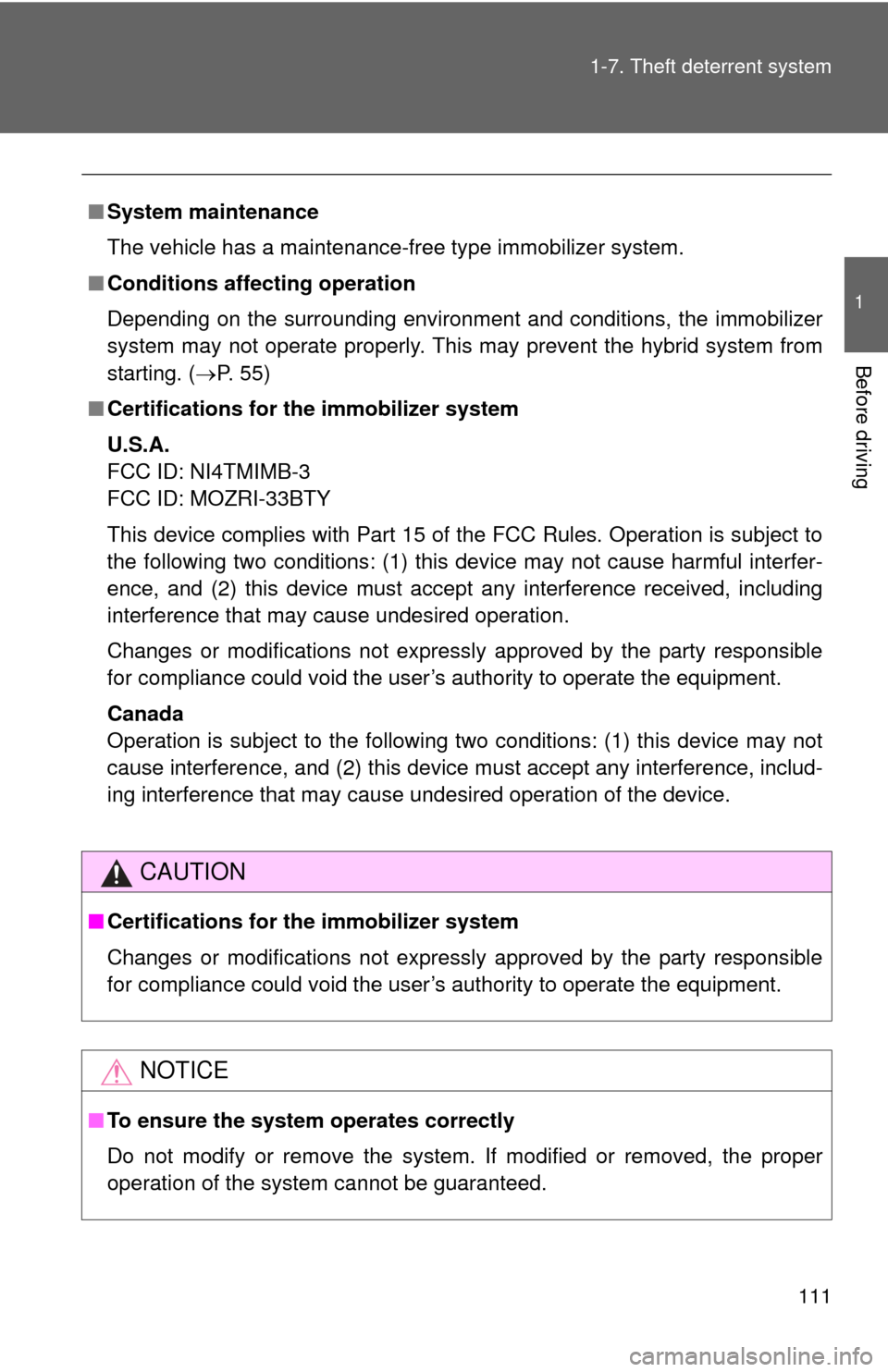
111
1-7. Theft deterrent system
1
Before driving
■
System maintenance
The vehicle has a maintenance-free type immobilizer system.
■ Conditions affecting operation
Depending on the surrounding environment and conditions, the immobilizer
system may not operate properly. This may prevent the hybrid system from
starting. ( P. 55)
■ Certifications for the immobilizer system
U.S.A.
FCC ID: NI4TMIMB-3
FCC ID: MOZRI-33BTY
This device complies with Part 15 of the FCC Rules. Operation is subject to
the following two conditions: (1) this device may not cause harmful interfer-
ence, and (2) this device must accept any interference received, including
interference that may cause undesired operation.
Changes or modifications not expressly approved by the party responsible
for compliance could void the user’s authority to operate the equipment.
Canada
Operation is subject to the following two conditions: (1) this device may not
cause interference, and (2) this device must accept any interference, includ-
ing interference that may cause undesired operation of the device.
CAUTION
■Certifications for the immobilizer system
Changes or modifications not expressly approved by the party responsible
for compliance could void the user’s authority to operate the equipment.
NOTICE
■To ensure the system operates correctly
Do not modify or remove the system. If modified or removed, the proper
operation of the system cannot be guaranteed.
Page 112 of 556
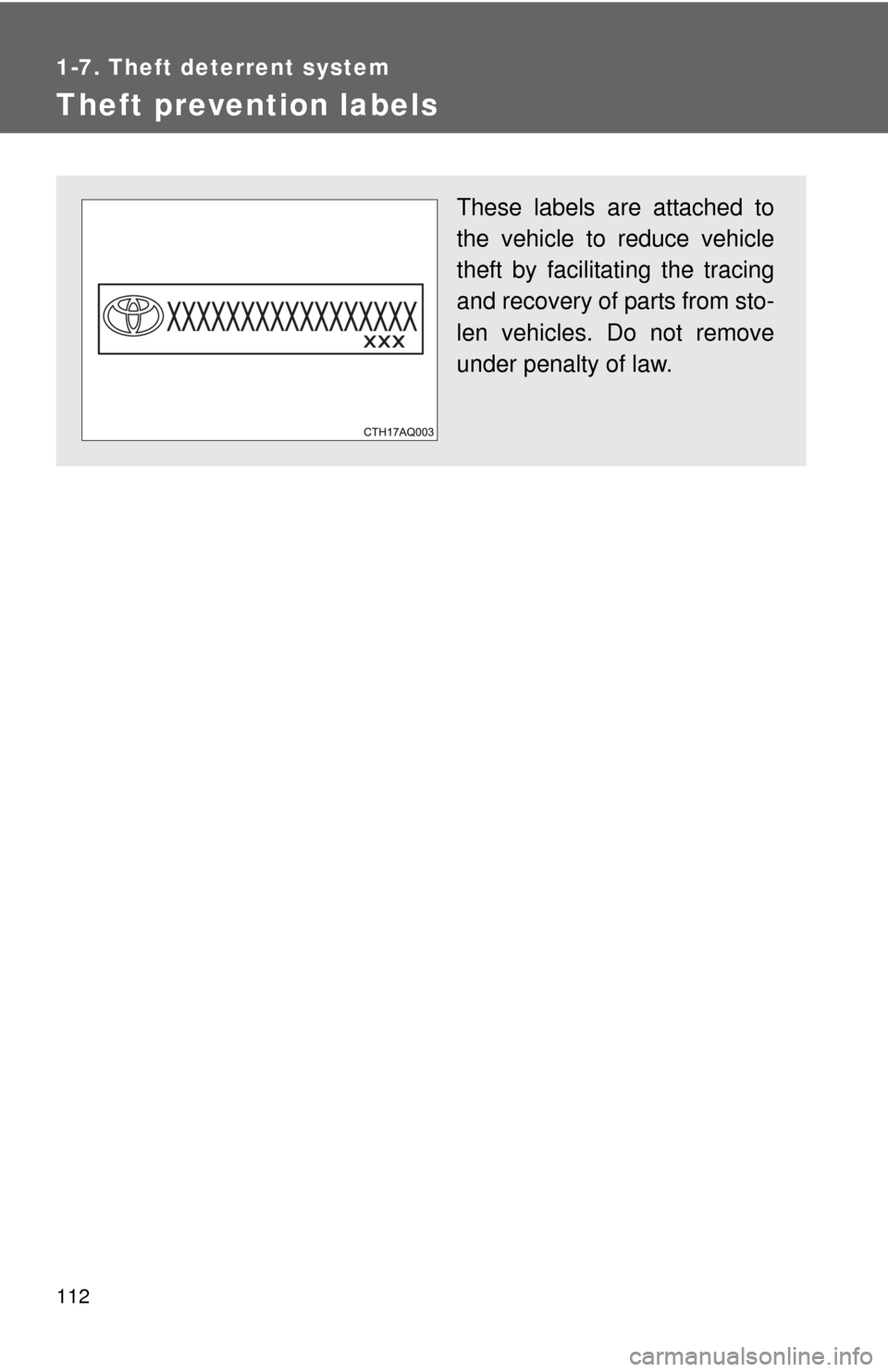
112
1-7. Theft deterrent system
Theft prevention labels
These labels are attached to
the vehicle to reduce vehicle
theft by facilitating the tracing
and recovery of parts from sto-
len vehicles. Do not remove
under penalty of law.
Page 113 of 556
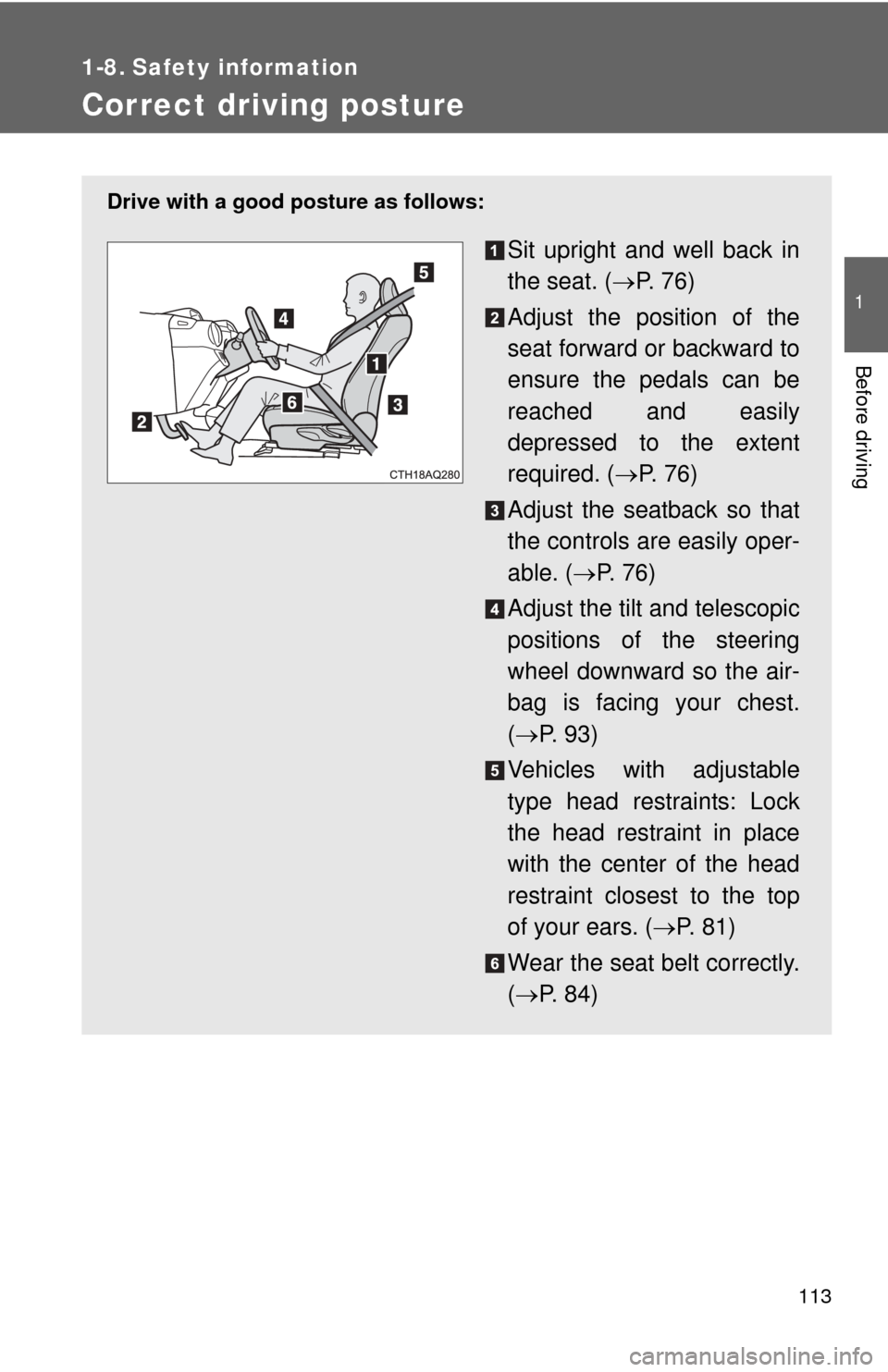
113
1
Before driving
1-8. Safety information
Correct driving posture
Drive with a good posture as follows:
Sit upright and well back in
the seat. (P. 7 6 )
Adjust the position of the
seat forward or backward to
ensure the pedals can be
reached and easily
depressed to the extent
required. ( P. 76)
Adjust the seatback so that
the controls are easily oper-
able. ( P. 76)
Adjust the tilt and telescopic
positions of the steering
wheel downward so the air-
bag is facing your chest.
( P. 93)
Vehicles with adjustable
type head restraints: Lock
the head restraint in place
with the center of the head
restraint closest to the top
of your ears. ( P. 81)
Wear the seat belt correctly.
( P. 84)
Page 114 of 556

114 1-8. Safety information
CAUTION
■While driving
●Do not adjust the position of the driver’s seat.
Doing so could cause the driver to lose control of the vehicle.
● Do not place a cushion between the driver or passenger and the seatback.
A cushion may prevent correct posture from being achieved, and reduce
the effectiveness of the seat belt and head restraint, increasing the risk of
death or serious injury to the driver or passenger.
● Do not place anything under the front seats.
Objects placed under the front seats may become jammed in the seat
tracks and stop the seat from locking in place. This may lead to an acci-
dent, resulting in death or serious injury. The adjustment mechanism may
also be damaged.
■ Adjusting the seat position
●Take care when adjusting the seat position to ensure that other passen-
gers are not injured by the moving seat.
● Do not put your hands under the seat or near the moving parts to avoid
injury.
Fingers or hands may become jammed in the seat mechanism.
Page 115 of 556
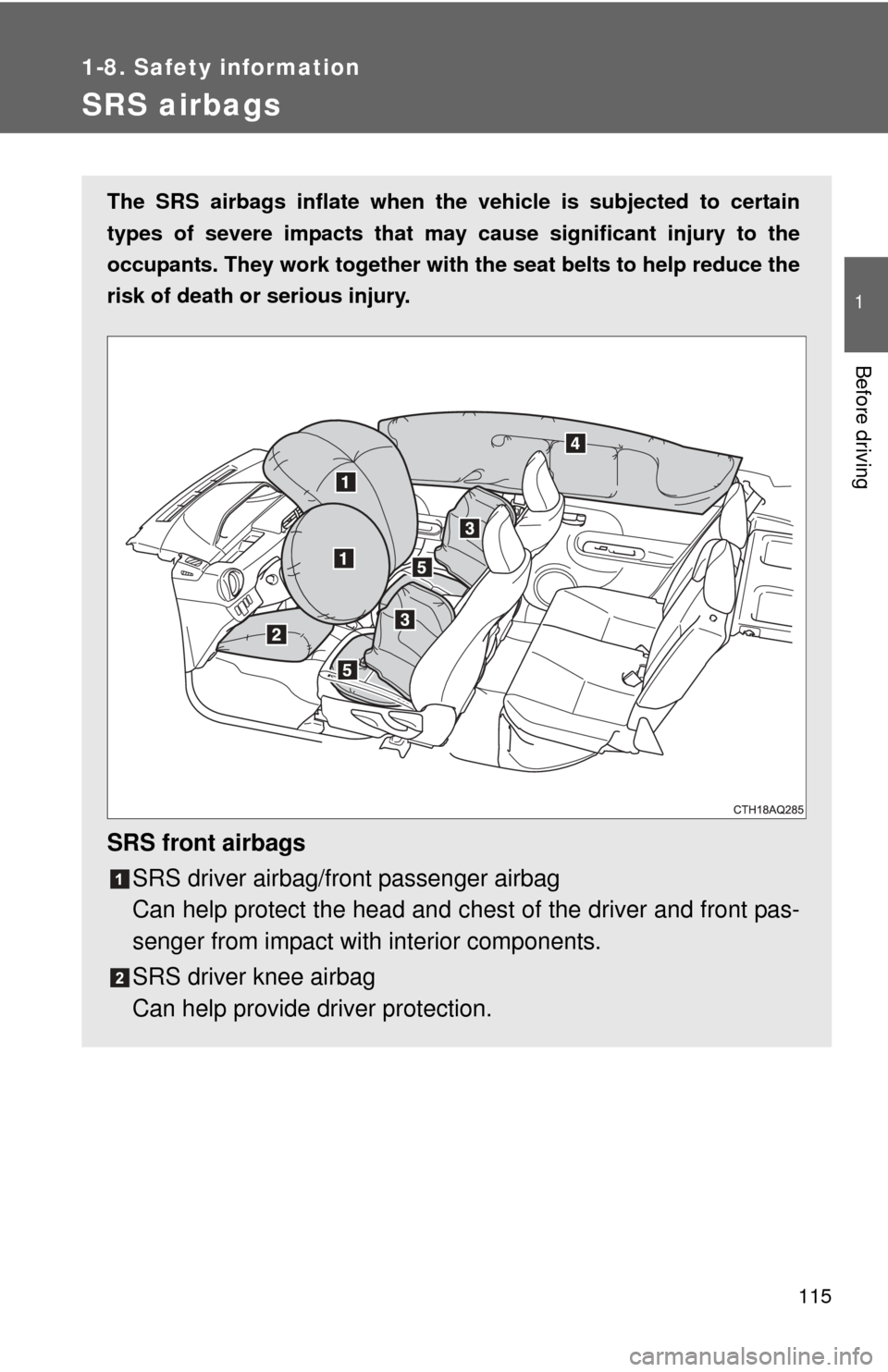
115
1
1-8. Safety information
Before driving
SRS airbags
The SRS airbags inflate when the vehicle is subjected to certain
types of severe impacts that may cause significant injury to the
occupants. They work together with the seat belts to help reduce the
risk of death or serious injury.
SRS front airbags
SRS driver airbag/front passenger airbag
Can help protect the head and ches t of the driver and front pas-
senger from impact with interior components.
SRS driver knee airbag
Can help provide driver protection.
Page 116 of 556
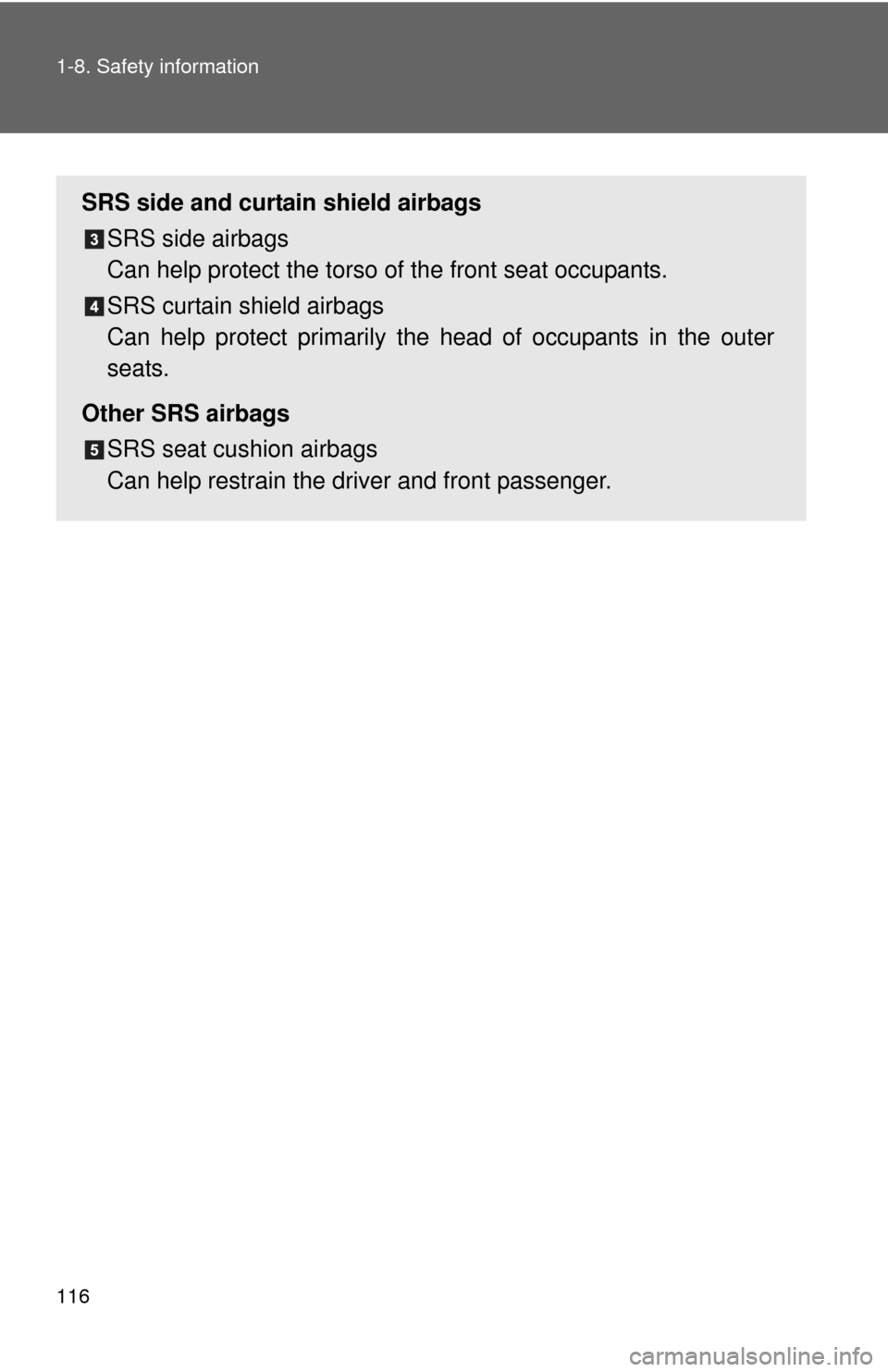
116 1-8. Safety information
SRS side and curtain shield airbagsSRS side airbags
Can help protect the torso of the front seat occupants.
SRS curtain shield airbags
Can help protect primarily the head of occupants in the outer
seats.
Other SRS airbags SRS seat cushion airbags
Can help restrain the driver and front passenger.
Page 117 of 556
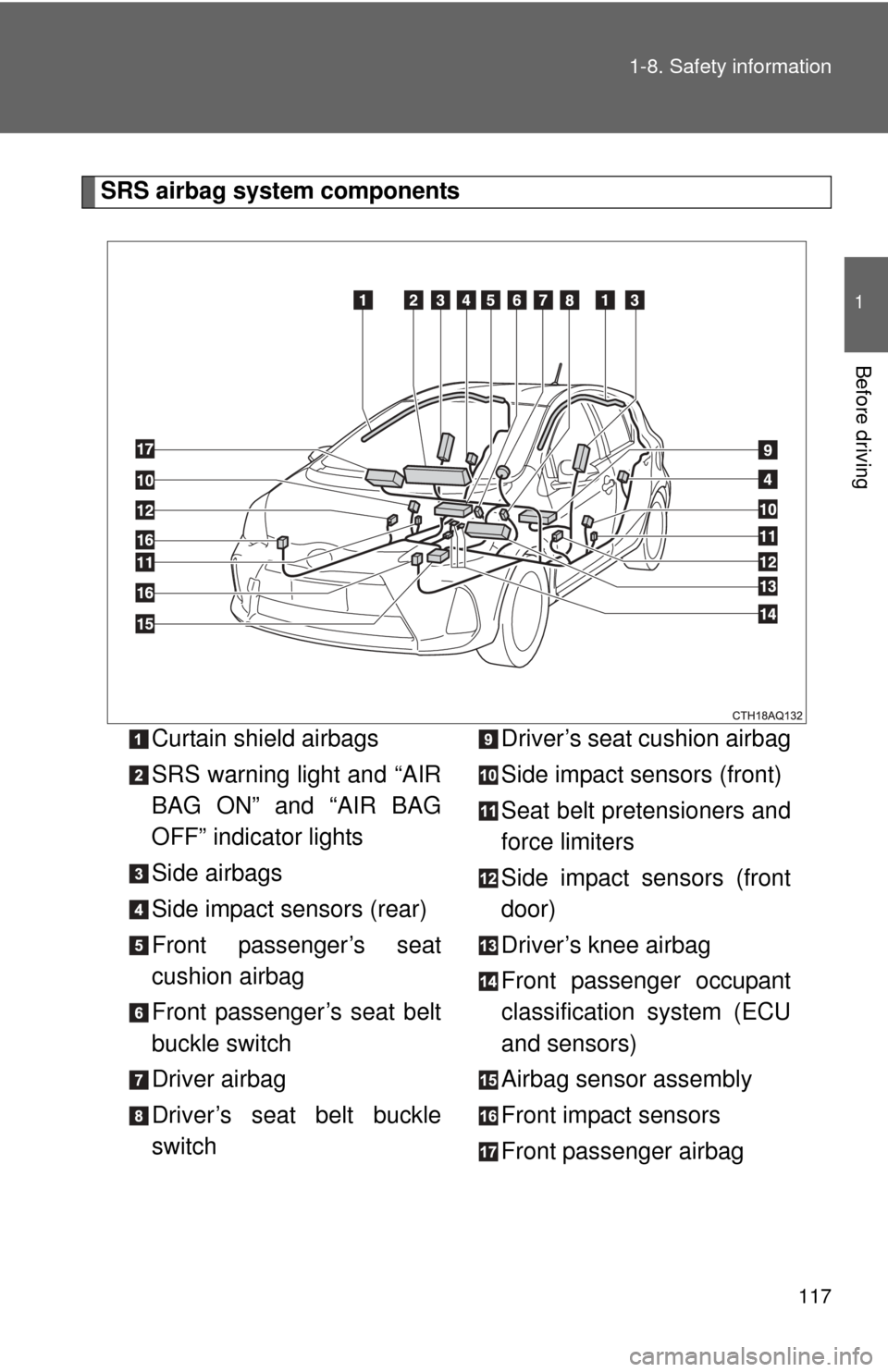
117
1-8. Safety information
1
Before driving
SRS airbag system components
Curtain shield airbags
SRS warning light and “AIR
BAG ON” and “AIR BAG
OFF” indicator lights
Side airbags
Side impact sensors (rear)
Front passenger’s seat
cushion airbag
Front passenger’s seat belt
buckle switch
Driver airbag
Driver’s seat belt buckle
switch Driver’s seat cushion airbag
Side impact sensors (front)
Seat belt pretensioners and
force limiters
Side impact sensors (front
door)
Driver’s knee airbag
Front passenger occupant
classification system (ECU
and sensors)
Airbag sensor assembly
Front impact sensors
Front passenger airbag
Page 118 of 556

118 1-8. Safety information
Your vehicle is equipped with ADVANCED AIRBAGS designed based
on the US motor vehicle safety standards (FMVSS208). The airbag
sensor assembly (ECU) controls ai rbag deployment based on infor-
mation obtained from the sensors etc. shown in the system compo-
nents diagram above. This inform ation includes crash severity and
occupant information. As the air bags deploy, a chemical reaction in
the inflators quickly fills the airbag s with non-toxic gas to help restrain
the motion of the occupants.
■ If the SRS airbags deploy (inflate)
●Bruising and slight abrasions may result from contact with a deploying
(inflating) SRS airbag.
● A loud noise and white powder will be emitted.
● Parts of the airbag module (steering wheel hub, airbag cover and inflator)
as well as the front seats, parts of the front and rear pillars, and roof side
rails, may be hot for several minutes. The airbag itself may also be hot.
● The windshield may crack.
■ SRS airbag deployment conditions (SRS front airbags/SRS seat cush-
ion airbags)
● The SRS front airbags and SRS seat cushion airbags will deploy in the
event of an impact that exceeds the set threshold level (the level of force
corresponding to an approximately 12 - 18 mph [20 - 30 km/h] frontal col-
lision with a fixed wall that does not move or deform).
However, this threshold velocity will be considerably higher in the following
situations:
• If the vehicle strikes an object, such as a parked vehicle or sigh pole,
which can move or deform on impact
• If the vehicle is involved in an underride collision, such as a collision in which the front of the vehicle “underrides”, or goes under, the bed of a
truck
Page 119 of 556
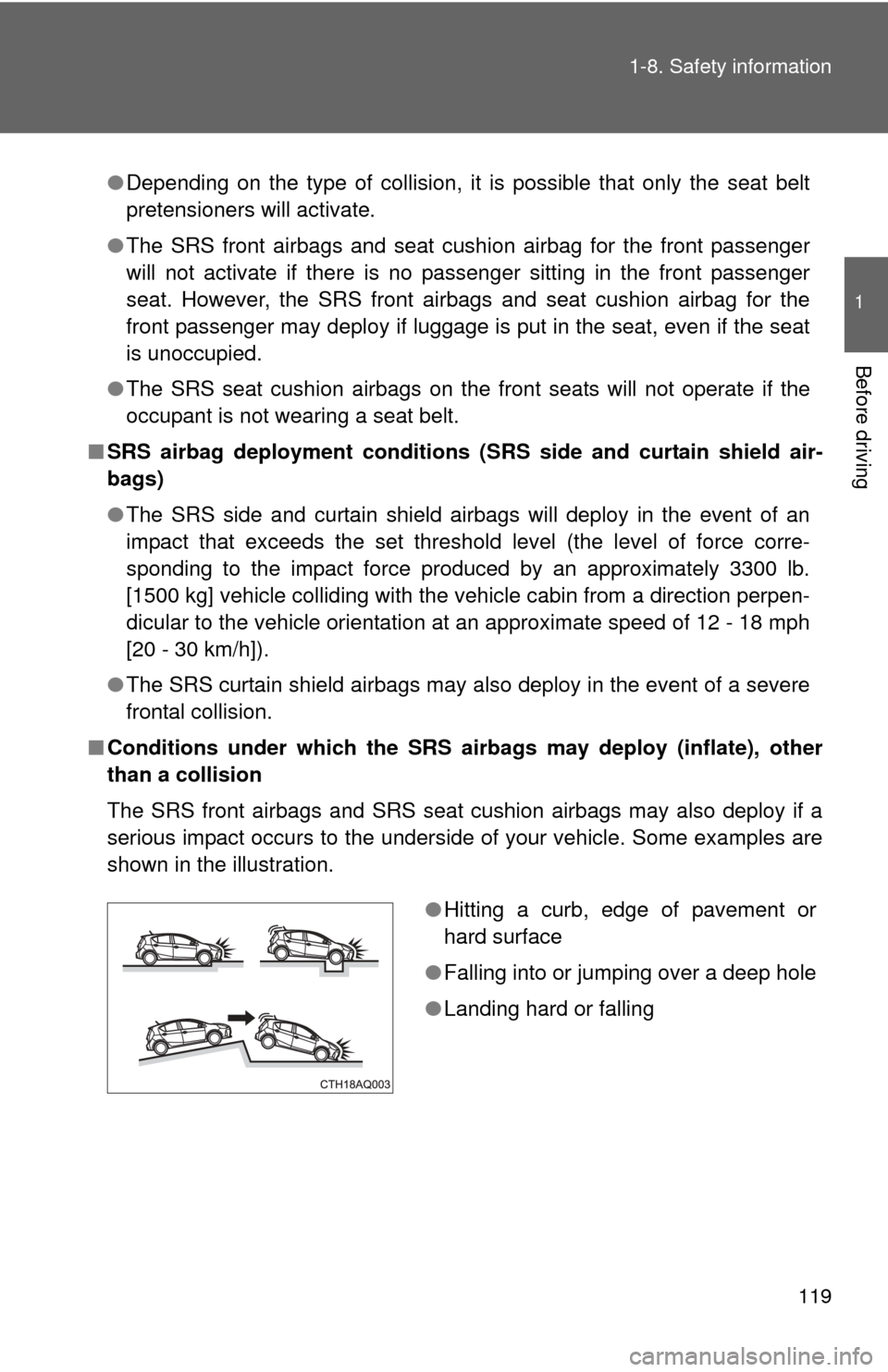
119
1-8. Safety information
1
Before driving
●
Depending on the type of collision, it is possible that only the seat belt
pretensioners will activate.
● The SRS front airbags and seat cushion airbag for the front passenger
will not activate if there is no passenger sitting in the front passenger
seat. However, the SRS front airbags and seat cushion airbag for the
front passenger may deploy if luggage is put in the seat, even if the seat
is unoccupied.
● The SRS seat cushion airbags on the front seats will not operate if the
occupant is not wearing a seat belt.
■ SRS airbag deployment conditions (S RS side and curtain shield air-
bags)
● The SRS side and curtain shield airbags will deploy in the event of an
impact that exceeds the set threshold level (the level of force corre-
sponding to the impact force produced by an approximately 3300 lb.
[1500 kg] vehicle colliding with the vehicle cabin from a direction perpen-
dicular to the vehicle orientation at an approximate speed of 12 - 18 mph
[20 - 30 km/h]).
● The SRS curtain shield airbags may also deploy in the event of a severe
frontal collision.
■ Conditions under which the SRS airbags may deploy (inflate), other
than a collision
The SRS front airbags and SRS seat cushion airbags may also deploy if a
serious impact occurs to the underside of your vehicle. Some examples are
shown in the illustration.
●Hitting a curb, edge of pavement or
hard surface
● Falling into or jumping over a deep hole
● Landing hard or falling
Page 120 of 556
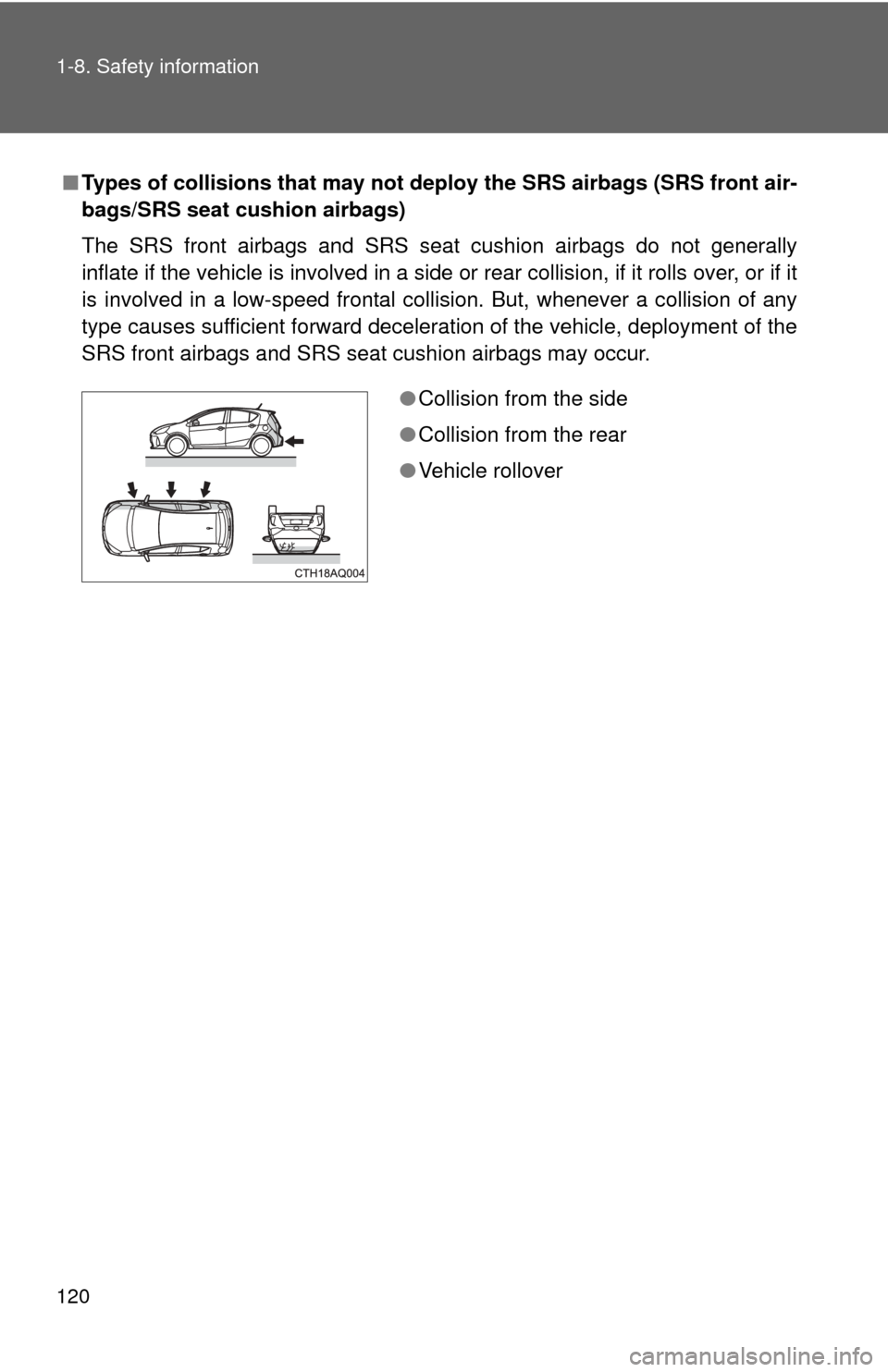
120 1-8. Safety information
■Types of collisions that may not de ploy the SRS airbags (SRS front air-
bags/SRS seat cushion airbags)
The SRS front airbags and SRS seat cushion airbags do not generally
inflate if the vehicle is involved in a side or rear collision, if it rolls over, or if it
is involved in a low-speed frontal collision. But, whenever a collision of any
type causes sufficient forward deceleration of the vehicle, deployment of the
SRS front airbags and SRS seat cushion airbags may occur.
● Collision from the side
● Collision from the rear
● Vehicle rollover